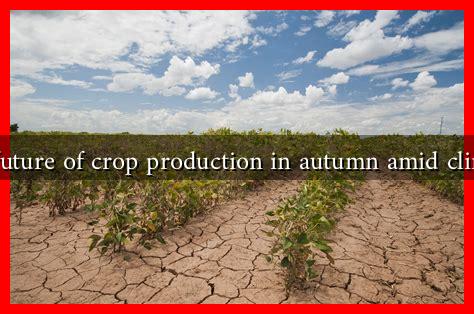-
Table of Contents
The Future of Crop Production in Autumn Amid Climate Change
As climate change continues to reshape our environment, the agricultural sector faces unprecedented challenges and opportunities. Autumn, a critical season for crop production, is particularly affected by shifting weather patterns, altered precipitation, and rising temperatures. This article explores the future of crop production in autumn, examining the implications of climate change and the innovative strategies that farmers and researchers are employing to adapt.
Understanding the Impact of Climate Change on Autumn Crop Production
Climate change is not a distant threat; it is a current reality that is already influencing agricultural practices. The autumn season, traditionally marked by harvests, is experiencing significant changes due to various climatic factors:
- Temperature Fluctuations: Rising average temperatures can lead to earlier planting and harvesting times, affecting crop yields and quality.
- Altered Precipitation Patterns: Changes in rainfall can result in droughts or excessive moisture, both of which can damage crops.
- Pest and Disease Proliferation: Warmer temperatures can expand the range of pests and diseases, posing new threats to autumn crops.
According to a report by the Intergovernmental Panel on Climate Change (IPCC), global agricultural productivity could decline by up to 30% by 2050 if current trends continue. This stark statistic underscores the urgency of addressing climate change in agriculture.
Innovative Agricultural Practices for Autumn Crop Production
In response to these challenges, farmers and researchers are adopting innovative practices to enhance crop resilience and productivity. Some of these strategies include:
- Climate-Resilient Crop Varieties: Breeding and genetically modifying crops to withstand extreme weather conditions is becoming increasingly important. For example, drought-resistant maize varieties have been developed in regions like sub-Saharan Africa, helping farmers maintain yields despite water scarcity.
- Agroecological Practices: Techniques such as crop rotation, intercropping, and organic farming can improve soil health and biodiversity, making crops more resilient to climate stressors.
- Precision Agriculture: Utilizing technology such as drones, sensors, and data analytics allows farmers to monitor crop health and optimize resource use, leading to more efficient production.
Case studies from around the world illustrate the effectiveness of these practices. For instance, in the Netherlands, farmers are using precision irrigation systems that adjust water supply based on real-time weather data, significantly reducing water waste and improving crop yields.
The Role of Policy and Community Engagement
Addressing the future of autumn crop production amid climate change requires a collaborative approach involving policymakers, researchers, and local communities. Key areas of focus include:
- Investment in Research: Governments and organizations must fund research into sustainable agricultural practices and climate-resilient crops.
- Education and Training: Providing farmers with the knowledge and tools to implement innovative practices is crucial for adaptation.
- Community Support Systems: Building networks among farmers can facilitate the sharing of resources, knowledge, and best practices.
For example, the Food and Agriculture Organization (FAO) has initiated programs that promote farmer-to-farmer learning, enabling communities to adapt to climate change collectively.
Conclusion: Navigating the Future of Autumn Crop Production
The future of crop production in autumn is undoubtedly intertwined with the realities of climate change. While challenges abound, the agricultural sector is also witnessing a wave of innovation and resilience. By embracing new technologies, sustainable practices, and collaborative efforts, farmers can navigate the complexities of a changing climate.
As we look ahead, it is essential to recognize that the choices made today will shape the agricultural landscape of tomorrow. By investing in research, supporting farmers, and fostering community engagement, we can ensure that autumn remains a season of abundance, even in the face of climate change.
For more information on sustainable agricultural practices, visit the FAO Sustainable Agriculture page.

